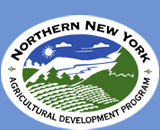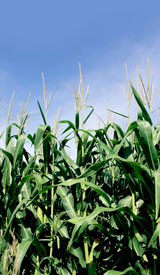

Northern New York Agricultural Development Program Press
Releases
June 26, 2006
Contact: Everett D. Thomas, WH Miner
Agricultural Research Institute, 518-846-7121 x115
Copper, Cows & Crops: NNY Research Evaluates How Dairy Footbaths
Affect Farm Crops, Field Lifetime
How does a footbath for dairy cows affect 1) crop yields and 2) how soon
a farm field reaches its state-regulated copper load? A team of
researchers funded by the Northern New York Agricultural Development
Program is working to answer those questions.
Copper sulfate is the most cost-effective treatment for controlling
hairy heel warts that cause lameness in dairy cows. The copper sulfate
used in the cows� footbaths is disposed of in manure slurry applied to
farm fields. Researchers are evaluating timothy and orchardgrass grown
in greenhouses using controlled applications of copper sulfate on sandy
loam and silt loam soils at the William H. Miner Agricultural Research
Institute in Chazy, NY. A field study on corn is now underway at the
Institute.
A Miner Institute survey of New York and Vermont farms estimates that
four to 16 pounds of copper sulfate is applied per acre per year. The
New York State Department of Environmental Conservation has set a
lifetime load limit for copper at 74 lbs/acre. Depending upon the
application rate, a field could reach its maximum load of copper in 4.5
to 19 years. Over those years, a farmer hopes to harvest maximum crop
yields.
�What we want to know is how much and how well copper sulfate is
tolerated by field crops,� says research team member Everett D. Thomas,
vice-president of agricultural programs at the William H. Miner
Agricultural Research Institute. �We know of no research that determines
how copper in sulfate form affects crop development on different soils.
The data from our project will determine how the rate of copper sulfate
application affects root growth, forage quality and yield.�
Thomas says farmers can consider several alternatives to reduce their
use of copper sulfate to obtain desired crop yields and guard cow foot
health. Those alternatives include adjusting the amount of copper
sulfate used in footbaths, reducing the frequency of footbaths, using
them less in the winter, and improving hoof trimming and stall surfaces.
Miner Institute was able to reduce its use of copper sulfate by sixty
percent and maintains its dairy herd�s hoof health through good hoof
trimming practices and use of rubber mats throughout the milking barn.
While Thomas says it is too early to release results, �some of the
results from the greenhouse study on the forage grasses were eye-opening
� big yield decreases where copper sulfate was used.� He is eager to see
the field corn study results.
The copper sulfate project research team includes Miner Institute�s
Director of Research Catherine S. Ballard, Forage Lab Director Kurt W.
Cotanch, and Research Associate Heather M. Dann. University of Vermont
Ph.D. graduate student Sally A. Flis is project leader.
The Northern New York Agricultural Development Program is a
farmer-driven research and education program specific to New York six
northernmost counties (Essex, Clinton, Franklin, Jefferson, Lewis, St.
Lawrence). For more information, visit
www.nnyagdev.org or contact Board Chairs Jon Greenwood, Canton,
315-386-3231, or Joe Giroux, Plattsburgh, 518-563-7523, or call R. David
Smith at Cornell University at 607-255-7286.
